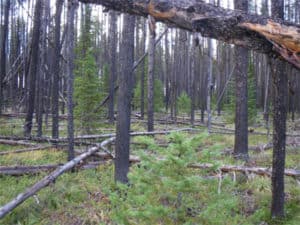Beaver Creek Project Area – Forest Service, USDA
The Beaver Creek Landscape Restoration Project on the Flathead National Forest was presented here when the district court upheld the decision (Friends of the Wild Swan v. Kehr). The Ninth Circuit affirmed the district court on May 10 on three claims that the project was inconsistent with the forest plan. Two of the claims involved road density requirements for grizzly bears where the court found the project would “result in a net gain towards” objectives for one subunit and that roads would be properly reclaimed in another.
Here is the court’s holding on the third claim (emphasis added):
Finally, appellants argue that the Forest Service violated NFMA and NEPA by failing to demonstrate compliance with the Forest Plan’s road density standards for elk habitat in the Beaver Creek Project area. While this argument has significant force, we ultimately conclude that the Forest Service demonstrated compliance with the Forest Plan. The Forest Plan contains a standard that requires “[a]reas with `moist sites'” to be managed “with open road densities that average 1 mile or less per square mile” during the elk use period. Moist sites are defined as sites “found at the heads of drainages, bordering streams or marshy meadows, or occupying moist swales or benches.” The Forest Service admits that the Project’s Environmental Assessment (“EA”) did not expressly provide a specific determination about road density in areas near elk moist sites. Indeed, the Forest Service did not identify specific locations of elk moist sites. Ultimately, we conclude that the Project satisfies the Forest Plan based on the fact that a large portion of the Beaver Creek subunit has an open road density of less than one mile per square mile and the Forest Service’s explanation in the EA that “moist sites occur primarily . . . in roadless and wilderness areas[.]” While the Forest Service could have done a better job demonstrating its compliance with the elk habitat road density standards by mapping moist sites and showing that open road densities near those moist sites will meet the Forest Plan’s standard, we nevertheless conclude that the Forest Service did just enough to comply with the Forest Plan, NFMA, and NEPA.
The lesson here is “don’t try this at home, folks.” This particular circuit panel (1 Clinton, 1 Bush and 1 Obama via Sarah Palin, if you wondered) went out of its way to construct a rationale for compliance which basically said there was a low probability of noncompliance, or the amount of noncompliance would be small. NFMA does not say that projects must be “probably or mostly consistent” with the forest plan. If the forest plan says certain kinds of areas must meet certain requirements (and the Forest Service wants a successful project), the project documentation must do what the Ninth Circuit said here: identify where those areas are and show how those requirements will be met in those locations. (And imagine doing that if you don’t know where the locations are.)
